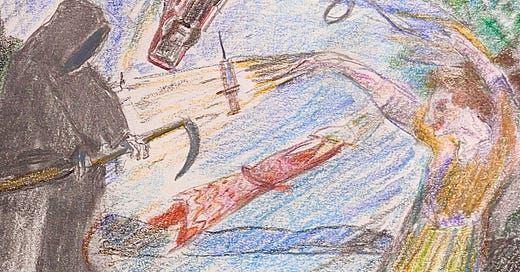It is Tuesday, a few days after writing last week’s essay about having to confront the nasty disapproval I harbor about the wrinkles now cast across my face like jagged cracks in a sidewalk. It is time for a haircut, so I am forced once again to come face to face with those cracks as I sit in the salon chair in front of the long floor to ceiling mirror and wait for M to finish up with another customer. On the car ride over, I listen to a news story about the devastating effects on Ukraine of our government’s failure to send aide for their war against Russia and I am abashed that my mind would now give the petty, self-obsessed topic of my wrinkles any airspace at all.
When the customer, a chatty woman M’s age, whose conversation with M about the travails of weight loss and body image I couldn’t help but overhear finally leaves, M greets me cheerfully. M has cut my hair for many years. She knew me when I was in my sixties, and I knew her when she was in her twenties. M owns her own studio and has an artist’s eye for color and design. Cascades of pink peonies festoon her big front window; black and white cabinets give the space a mid-century modern vibe. “Well, how are you today?” she asks standing behind the chair, both of us now confronted with that mirror and making connection through the reflection in that glass accuser.
I come right to the point. “I’m fine today, the sun is lovely, but, oh! I am having trouble with these wrinkles. There are so many more of them than even a year ago. They seem to multiply by some ruthless algorithm.” What am I looking for from this woman who stands before a mirror all day long, absorbing, confronting, shepherding, shaping, that perilous thing called beauty? She doesn’t miss a beat in her answer. “You could do something about them, you know. You don’t have to live with them.”
Her answer is strangely derailing. I know M to be a person who has given a lot of thought to the danger of beauty products, both to the health of the consumer and to the earth. Her shelves are lined with products sourced from small companies practicing sustainably. I think of her as a gutsy woman who doesn’t shy away from challenging our consumer, success driven culture. “You could get injections”, she hastens to explain. “Injections? You mean Botox?” “Yup, she says. You have a choice.”
Her answer stirs the rebellious streak in me. I don’t see anything liberating or empowering about the choice to have Botox, rather I see it as a surrender to THEM, to the destructive capitalistic, patriarchal, consumer driven forces at loose in our culture. I decide on the spot that I am finally going to get the haircut I’ve not had the courage to get before this. “Let’s cut it all off, go really short,” I tell her. “I’m ready. Androgyny beckons. Femininity be damned.”
I leave the studio feeling defiant and strong. I dare you, says the haircut, not to look at this face in all its wrinkled glory.
“Tell me about your face. Tell me about your tiny wrinkles around your eyes.” All week my curiosity about how women in their 40’s and 50’s are dealing with “the choice” has prompted me to have many conversations with women that age, many of whom sport the shiny cellophane face of Botox. All of them tell me the same thing: that they feel pressure to “stay in the game” by looking young; that they fear becoming invisible if they let those wrinkle lines around the eyes and the mouth show up; that they and all of their friends are willing to spend exorbitant amounts of money to inject a form of botulism into their faces in order to numb and relax the muscles in the face that lead to: wrinkles. All of these women have careers and most of them have a man in their lives. The women without a man in their life feel particularly vulnerable to the wrinkles=invisible story.
When Susan Sontag was writing so eloquently about beauty and age in the mid-seventies, women were not yet powerful players “outside” the home. Her writings imply that if women were able to gain power they would not need to rely on beauty as their only source of recognition. Sadly, has not happened. Women are still enslaved by beauty, defined, as Sontag said, as the beauty of the girl.
“Beauty, women’s business in this society, is the theater of their enslavement,” Sontag wrote. “Only one standard of female beauty is sanctioned: the girl.”
The girl. As yet unmarked by time and sorrow. Dandelions. Daises. Dolls. Not Death. Not Death. Not grief. Not sorrow or loss. Is that the importance of girl-like beauty? And what is Botox? Is it an offering thrown at Death to keep her far away, on the other side of the mountain, on the other side of consciousness?
It’s not my wrinkles I need to embrace, it’s loss and soon, my own death.
And it’s the deaths of millions of species and the deaths of a species that looks like me from starvation and heat and drowning, happening now, at this time some call the beginning of the second Great Dying.
250 million years ago, before the dinosaurs, the Great Dying occurred. During the Permian-Triassic Mass Extinction 90% of life in the oceans and 70% of life on land died. Scientists who study that event are warning us that we could be facing, at a much more rapid pace, another Great Dying and see many signs that the Great Dying has already started. Professor Uwe Brand from Brock University in Canada is a geoscientist who studied the Great Dying and has written extensively on it. He tells us that:
Right now our emissions are 10 to 20 times higher than what happened at the end of the Permian mass extinction, which was the largest and biggest mass extinction….The way I see it is, it is going to happen if we don't stop it or don't mitigate what we are doing.
Death.
What else are we offering to Death to keep her at bay? Overworking, gigantic houses, helicopter parenting, big cars, fast fashion, fish farms, iPhones, AI. Offerings which increase our emissions, increase our chances that the Great Dying will happen again. Soon.
What if we were to stop, to learn to sit with loss and grief and death? What if there were rituals for death that were joyful and portrayed death not only as loss but as a turning, a great mystery of the soul. Last Sunday, St. Patrick’s Day, we had the family here for our annual It’s Great to Be Irish gathering. I made Irish Soda bread of course and we posed for a family picture holding the banner inherited from my mother-in-law, Mary Dunne, It’s Great to Be Irish printed in green across it’s white background.
This St. Patrick’s Day I had one request from the family: that we all sing Danny Boy together. My father sang Danny Boy every St. Patrick’s day, a whiskey in one hand, his other on one of our shoulders. My uncle sang the song at our wedding. The song is a song of grief, written by a mother to a son who is going off to war. Curiously, the mother anticipates not the son’s death, but her own, and imagines her son on his return from war:
But when ye come, and all the flowers are dying, If I am dead, as dead I well may be, You’ll come and find where I am lying And kneel and say an Ave there for me. And I shall hear, though soft you tread above me, And all my grave will warmer, sweeter be, For you will bend and tell me that you love me, And I shall sleep in peace until you come to me! When we all sang this tune last week, off key and erratically, I wept. A sweet weeping, a remembering and carrying of my father here beside me and my family. While we stand and sing, I imagine my children and grandchildren kneeling at my own grave, warmer for their presence, their love entangled with the earth where my body will soon sleep. A few weeks ago I had another experience with grief, this time with a community grief ritual to recognize the many losses communities up and down the coast of Maine have endured from the winter storms that tore trees, homes, docks, stairways, fishing infrastructure, miles of dunes from their resting places, altering our coastline and the lives of people and marshes and frogs and waterfowl in heartbreaking ways. The ritual was envisioned not by a therapist or an environmental activist, but by an artist, Matt Cahill, the cofounder and director of Hogfish, a regenerative arts company located in Cape Elizabeth that describes itself as “on a quest to build an artistic sanctuary and body of work to restore a healthier dynamic balance between our planet, the stories we tell, and the way we live.” Over the course of an afternoon, seventy-five people descended through ritual deep into our bones, touched the inner life force of earth and together held our collectively grieving soul. Together we found the courage to share that grief with others and out of that sharing rose joy, our joy at being together and part of this wildly beautiful world. We sang, we wrote, we drummed, we listened to music, we held hands, we cried. At the end, I felt nurtured, prepared to go back out into the suffering world and take up my work.







Lovely essay, K.! There's the true beauty not even twenty barrels of Botox could provide. Death holds us all in her sweet grip, though we sing in our chains like the sea as Dylan Thomas said. Me, I'm looking at ear iobe reduction-. I'm tired of looking like one of those stupid Hotei buddhas! Maybe a tummy tuck too. The grotesque search and imitation of youth; it's anti-life actually.
It's liberating to know one is a citizen of Deep Time, that all ones fears and concerns, searches for lost youth, for social justice- all will "go a glimmering."
That oneself and all the species will be lost in deep time and it will be as if we all never existed even the memories long lost. That's liberating, joyful, life-affirming actually!
Exquisite as always, Kathleen (I felt like calling you Kitty there because the girl is still alive and well IN YOU!). Thank you! I’m so glad you included my favorite Renaissance sculpture: the Pieta, for we enter Holy Week today. Although we will raise palms and sing “Hosanna”, this is also Passion Sunday. You give me so much to think about! I share this piece from Louise Erdrich’s 2005 novel “The Painted Drum:”
“Life will break you. Nobody can protect you from that, and living alone won’t either, for solitude will also break you with its yearning. You have to love. You have to feel. It is the reason you are here on earth. You are here to risk your heart. You are here to be swallowed up. And when it happens that you are broken, or betrayed, or left, or hurt, or death brushes near, let yourself sit by an apple tree and listen to the apples falling all around you in heaps, wasting their sweetness. Tell yourself that you tasted as many as you could.”*
Let’s eat apples together, Dear Friend, and share wrinkle stories and passion to save this planet for future humans!❤️
*Originally posted by Maria Popova in her Marginalian.